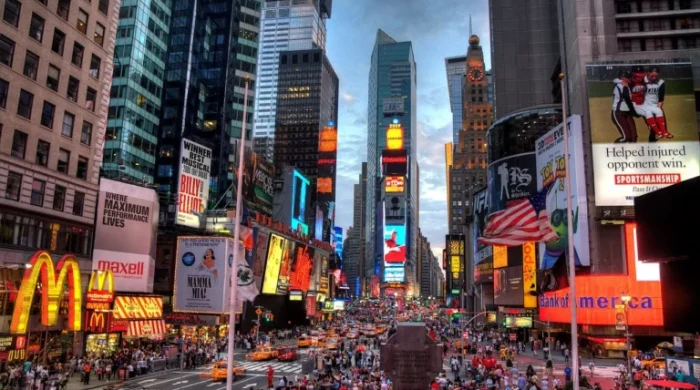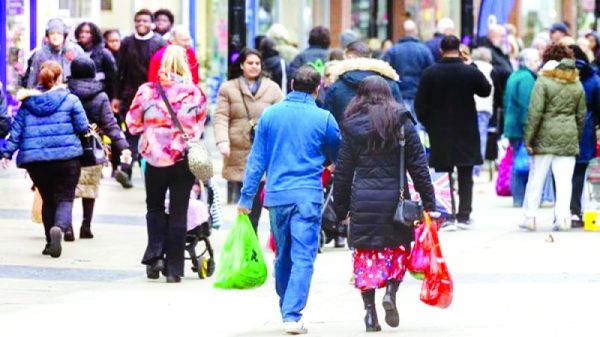Tourists Go Home! Fed Up With Over-Tourism, European Hotspots
- আপডেট সময় মঙ্গলবার, ১ আগস্ট, ২০২৩

traffic, noise, pollution and litter, many popular destinations in Europe are swapping their ‘come-to-us’ tourism campaigns for ‘please-don’t’ anti-tourism strategies — and some of the measures to discourage visitors are quite severe.
Literally overrun by tourists, a number of the most iconic destinations have become unlivable for local residents and overcrowded, unsafe and uncomfortable for visitors. The beauty, serenity and simplicity of many of the most bucolic and sought-after destinations in Europe can’t survive millions of annual arrivals.
Although it hasn’t reached the level of a government, the debate around how to handle tourist overflows has started. Tremendous numbers of tourists — once the golden goose for these hot spots — are precisely the cause of the current backlash.
NATO Planes Watched As Three Civilian Ships Ran Russia s Naval Blockade Of Ukraine
Archer EVTOL Deal With Air Force Could Ground Choppers
38 Most Affordable Places For Last Minute Summer Travel According To Priceline
“Overtourism is already so acute that popular destinations are now doing the unthinkable, and actively trying to dissuade or block arrivals,” writes The Guardian. “The world’s most perfect places are being turned into backdrops for our tourist selfies. Mass tourism is turning destinations into the opposite of what they once were.”
Central Amsterdam’s legendary Damrak Road on a typical summer day
Around the continent, but especially among the most popular cities and towns, locals say they can’t take more of the destructive effects of overtourism. Venice, for example, is so overwhelmed by the number of visitors that it has introduced an entrance fee ranging from €3 to €10 to access the city and its islands.To manage the crowds, Greece has implemented a time-slot system for visitors to the Acropolis.
Nor are the hordes a treat for tourists themselves, trapped in long queues just to get onto footpaths, buy a drink, enter a restaurant, or board a train, plane or bus. Natural or man-made wonders and even churches have been monetized.
‘”Tourists are waiting more than two hours to visit the Acropolis in Athens,” AP recently reported. “Taxi lines at Rome’s main train station are running just as long. And so many visitors are concentrating around St. Mark’s Square in Venice that crowds get backed up crossing bridges — even on weekdays.”
Pristine woods, beaches and quaint small towns are sometimes so full of people that visitors have no alternative but to follow the direction of the crowds. Museums can be so jammed that to see a popular exhibit requires reservations booked months in advance. And even then, it’s difficult to see and appreciate the art works due to the amounts of people surrounding them.
The World Tourism Organization predicts that by the end of this decade, the flow of international tourists will surpass an astounding two billion.
Local and national governments have been under pressure to find solutions to the mass tourism boom and some have set recent restrictions in place.
One of the world’s largest cruise ships, “Millennium,” entering Amsterdam harbor.
GETTY IMAGES
Amsterdam
Amsterdam has voted to ban cruise ships from entering its main port. That comes on the hills of a wider crackdown that city officials call a “discouragement campaign,” and that, among other measures, bans outdoor marijuana smoking in the red-light district, while official digital and poster campaigns target young British men, encouraging them to “stay away.”
The measures, as mayor Femke Halsema has explained, are intended to discourage visitors from taking a “vacation from morals,” and control the tourist influx and the disruption they bring to the beautiful city with its picturesque architecture, incomparable museums, peaceful canals and also its red light district and coffee shops that sell marijuana.
With fewer than one million inhabitants, Amsterdam attracts more than one million tourists on average per month.
Despite controversy around the banning of the cruise ships, the government explained that the giant vessels in the city center “do not fit in with the task of combating mass tourism and are not in line with the sustainable ambitions of the city.”
Amsterdam, hailed as a highly tolerant, liberal city, has become, according to Lonely Planet, “increasingly regulated over recent years.” Officials have said that no moral judgment is involved in curbing disproportionate numbers of “men aged 18 to 35 that only come to party and use our city as a backdrop,” city spokeswoman Carina Noordervliet told the guide. “The discouragement campaign is targeted at a group of people who in general don’t contribute to the city in a positive way.”
Street signs are part of the campaign ‘Stay Away’ to deter rowdy visitors from coming to Amsterdam
GETTY IMAGES
Italy
Italy, which since 2021 bans large cruise ships in Venice’s historic lagoon, has enforced measures in Rome to restrict access to the Trevi Fountain and the Spanish Steps. It also started charging entry fees to visit the Pantheon in an effort to control the crowds and protect the famous architectural marvel.
Since June, the city of Florence is banning new short-term private vacation rentals in its historic center, which is a Unesco protected heritage site.
In Portofino, one of the country’s most charming seaside towns in the Italian riviera, the local government introduced legislation to dissuade tourists lingering for selfies in “no-waiting zones,” which include the most photogenic hotspots. Fines run as high as €275, BBC reports.
“The mayor of Portofino, Matteo Viacava, said that ‘anarchic chaos’ had been created by tourists stopping to take pictures and resulted in massive traffic jams and blocked streets.”
As explained by The Guardian, those measures “are among the latest in a series of draconian decisions adopted by Italian councils to deal with herds of holidaymakers: fines as high as €2,500 for walking the paths above the Cinque Terre (five villages in Liguria) in flip-flops or sandals; prohibitions on eating snacks outside in the center of Venice or on four central streets in Florence; a €250 fine simply for sitting down on Rome’s Spanish Steps.
One beach in Eraclea has even banned the building of sandcastles — maximum fine €250 — because they’re considered unnecessary obstructions.”
Florence on a typical summer day
GETTY
France
In Nice, on the French Riviera, with the deep blue waters of the Cote d’Azur at its feet, unusual pieces of street art were recently installed at places highly frequented by tourists: giant rat traps “to eradicate and eliminate the tourist pest” with a giant ice cream as bait. “To curb mass tourism, street artist ‘TooLate’ offers a radical solution” writes FranceInfo.
The giant traps are a humorous approach but also a clear display of the city’s feelings toward excessive tourism.
At government level, a plan “to better regulate tourist flows and support local authorities experiencing surges in visitor numbers” was unveiled last month. Le Monde reports that “Alliance France Tourisme, which brings together companies in the sector, pointed to ‘France’s belated awareness’, saying that the country was now one of the destinations condemned to ‘over-tourism.’
In addition to pooling information through a digital platform on best practices and regulations, a guide, and an observatory, the government will launch a €1 million campaign in March 2024 to encourage domestic and foreign tourists “to adapt their destination choices and schedules.”
Spain
One of the most popular pilgrimage destinations, Santiago de Compostela in Galicia, is planning to launch a tourist tax as a way to combat over-tourism. “With the city receiving more than 300,000 tourists as well as pilgrims each year, the authorities no longer want Santiago de Compostela to be a ‘theme park’,” Schengenvisa reports.
Local officials are also planning to set controls on the number of tourists in the city’s historic center.
In Mallorca, which after overcrowded Ibiza has become the hottest spot of the Balearic islands, is becoming a hotbed of anti-tourist protest:
“Mallorca hits rock bottom! ‘ writes the The Mallorca Daily Bulletin in an article about the fury of local residents over near-naked tourists wandering around the shops and streets of the picturesque towns.
“Bylaws in the municipality of Calvia now forbid walking “naked or half-naked” through the streets; the same goes for Palma (Mallorca’s capital) and Playa de Palma, and in recent years fines have been repeatedly issued in other resorts such as Magalluf,” the paper writes.
A similar measure has already been introduced in Barcelona, where a recent local graffiti campaign misdirects tourists away from the crowded Gaudi-designed Park Guell.
Levante Beach in Benidorm a seaside resort on the eastern coast of Spain, part of the Valencia … [+]
AFP VIA GETTY IMAGES
In Ibiza, a group of activist members of the ‘Futuro Vegetal’ movement targeted a €300 million super-yacht this month. They sprayed red paint on the mega-yacht Kaos owned by Nancy Walton Laurie, the billionaire heiress of the Walmart company.
They also smeared black paint on the cherries of the famous Pacha discotheque, stormed with banners the luxury beach club Blue Marlin in Cala Jondal, targeted a private jet at Ibiza airport and spray-painted a Lamborghini.
Portugal
In Portugal, playing loud music at many of the most popular beaches can be punished with fines ranging from €200 to €36,000. The Algarve coast alone, for example, sees more than one million mainly British tourists during the peak season. The fines range between €200 and €4,000 for individual and from €2,000 to €36,000 for groups.
The list of bans and restrictions in Portugal that travellers may face at beaches include unauthorised ball games, camping outside campsites, fishing in bathing areas and overflight by aircraft below 1,000 feet, except for those intended for surveillance or rescue operations.
Tourists fill the old town at the center of Dubrovnik, Croatia
GETTY
Croatia
As part of a “Respect the City” campaign, the ultra-popular city of Dubrovnik has initiated a luggage drop-off system to minimize the noise of wheeled suitcases on the cobbled streets of the picture-book city center. According to SchengenVisaInfo “starting in November, compulsory lockers will be put in place by the municipality at several points in this city where it will be banned to travel with luggage.”
The new measures to control over-tourism also include bans on sleeping in public areas, urinating in public spaces, climbing on top of monuments, drinking behavior and drinking alcohol near protected public spaces including schools and drug-related offenses, all of which are punishable with high fines and jail sentences.
Dubrovnik has already recorded 289,000 arrivals and 763,500 overnight stays since the beginning of this year.























